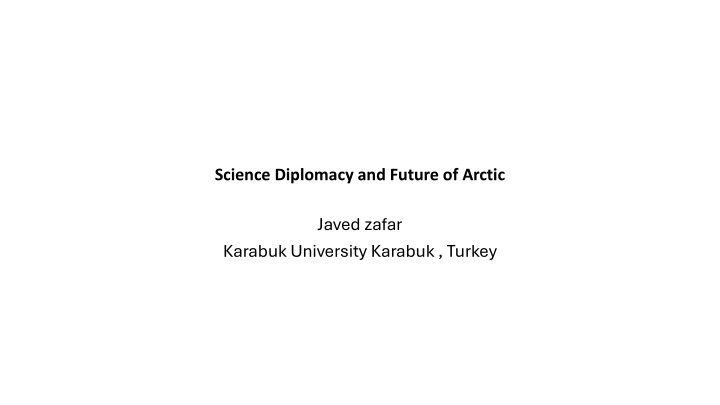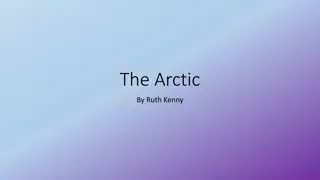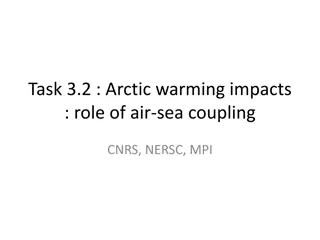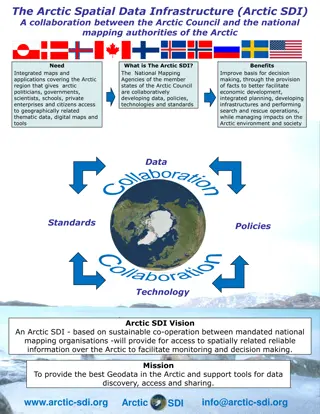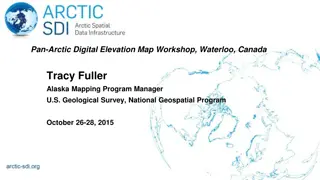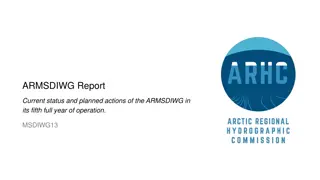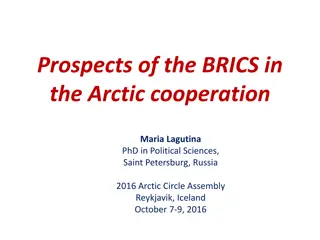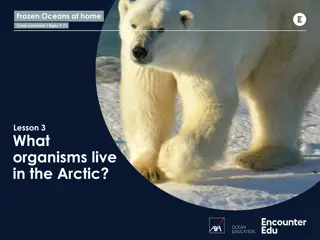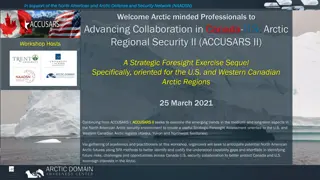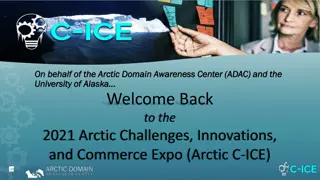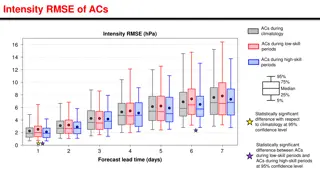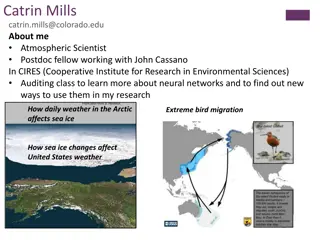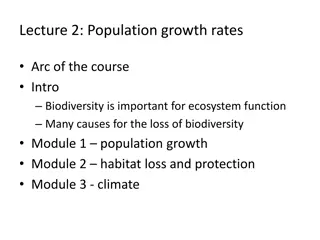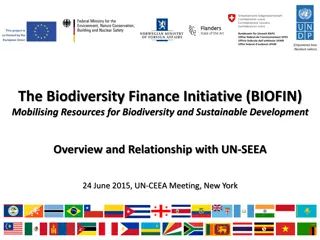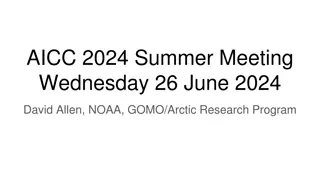Importance of the Arctic in Global Climate Systems and Biodiversity
The Arctic plays a critical role in regulating Earth's temperature, supporting unique biodiversity, sustaining indigenous communities, and offering abundant natural resources. Its significance transcends geographical boundaries and impacts the planet's environmental balance, climate systems, and geopolitical dynamics.
Download Presentation

Please find below an Image/Link to download the presentation.
The content on the website is provided AS IS for your information and personal use only. It may not be sold, licensed, or shared on other websites without obtaining consent from the author.If you encounter any issues during the download, it is possible that the publisher has removed the file from their server.
You are allowed to download the files provided on this website for personal or commercial use, subject to the condition that they are used lawfully. All files are the property of their respective owners.
The content on the website is provided AS IS for your information and personal use only. It may not be sold, licensed, or shared on other websites without obtaining consent from the author.
E N D
Presentation Transcript
Science Diplomacy and Future of Arctic Javed zafar KarabukUniversity Karabuk, Turkey
Whyarcticis important The Arctic is not just a remote and frozen wilderness; it is a cornerstone of Earth's environmental balance and a crucial area for biodiversity, culture, and international collaboration. Protecting and understanding the Arctic is vital for the planet s future. The Arctic holds immense importance for the environment, global climate systems, biodiversity, indigenous cultures, and geopolitical interests. Here's an overview of its significance.
1. Climate RegulationGlobal Thermostat: The Arctic plays a key role in regulating Earth's temperature. Its reflective ice cover (albedo effect) bounces sunlight back into space, helping cool the planet.Carbon Storage: Permafrost in the Arctic contains vast amounts of carbon. If thawed due to warming, it could release methane and CO , intensifying climate change.Ocean Circulation: The Arctic influences global ocean currents through thermohaline circulation, which impacts weather patterns and marine ecosystems worldwide. 2. BiodiversityThe Arctic supports unique species like polar bears, Arctic foxes, walruses, and seals, as well as migratory birds and marine life such as narwhals and whales.Its ecosystems are specially adapted to extreme conditions, making them particularly vulnerable to climate change and human activities. 3. Indigenous CommunitiesThe Arctic is home to numerous Indigenous peoples who have adapted to its harsh environment for thousands of years, such as the Inuit, Saami, and Nenets.Their cultures, traditions, and livelihoods depend on the health of Arctic ecosystems, especially through hunting, fishing, and herding.
4. Natural ResourcesTheArctic is rich in resources like oil, natural gas, minerals, and fish stocks. These resources are increasingly accessible due to melting ice, leading to economic opportunities and geopolitical competition.Sustainablemanagement of these resources is crucial to prevent environmental degradation.5. 5 Scientific ResearchTheArctic serves as a natural laboratory for studying climate change, glaciology, oceanography, and ecology.Researchin the region provides insights into Earth's past climates and helps refine predictions for future environmental changes. 6. Geopolitical ImportanceWith melting ice opening new shipping routes (e.g., the Northwest Passage and Northern Sea Route), the Arctic has become a strategic region for trade and military interests.Arcticnations (e.g., Russia, Canada, the U.S., Norway, and Denmark) and other global powers are increasingly competing for influence and access to resources. 7. Global Impacts of Arctic ChangesMeltingArctic ice contributes to sea level rise, threatening coastal communities worldwide.Thewarming Arctic affects global weather patterns, contributing to more frequent and severe storms, droughts, and temperature extremes.
After Ukraine crisis Russa was suspened form Arctic councile and its presidency. Arctic is not only important for arctic countries but also for the world , because of verious reasons. Western countries are adament for not to Cooperate w th Russia. Ukraine crisis is far to solve in verynear future. Cooperation is essantial to save arctic Russia is most important players because of its largest share. If tredational methods are not working , need to find out non tredational or unorthodox ways.
Sciencediplomacy Science diplomacy involves leveraging scientific collaborations and exchanges to address global challenges, foster international partnerships, and promote peace and security. The success of science diplomacy often depends on the intentions and approaches of a country's foreign policies. science diplomacy holds great potential for fostering international collaboration and addressing global challenges.
Science diplomacy (SD) operates through three primary dimensions: "science in diplomacy," "science for diplomacy," and "diplomacy for science. Science in Diplomacy involves the direct application of scientific knowledge to support diplomatic processes. This dimension focuses on providing scientific advice and evidence to inform and support decision-making in foreign and security policies Science for Diplomacy leverages science as a tool of soft power to advance diplomatic objectives. This approach uses scientific collaboration to build bridges between nations, fostering goodwill and mutual understanding.
Diplomacy for Science employs diplomatic efforts to facilitate international scientific collaboration. This dimension focuses on using diplomatic channels to negotiate research and development agreements, establish exchange programs, and enable the creation of international research infrastructures.
Dimensions The politics and geopolitics of the Arctic can be understood through three interconnected layers or dimensions: local, regional, and global.
LocalDimension Local Dimension: Russian Domination At the local level, Russia holds a dominant position due to its status as the largest Arctic country, with significant territorial claims and interests in both strategic and non-strategic areas. Russia's extensive Arctic coastline and substantial natural resources, such as oil and gas reserves, give it a considerable influence in the region. The country's investments in Arctic infrastructure, including icebreaker fleets and military bases, further cement its dominance and ability to project power within the Arctic
RegionalDimension Regional Dimension: Interaction among Arctic Nations At the regional level, all Arctic countries Canada, Denmark (via Greenland), Finland, Iceland, Norway, Sweden, and the United States interact based on their national and regional interests. These interactions are facilitated through organizations such as the Arctic Council, which provides a forum for discussing issues like environmental protection, sustainable development, and indigenous peoples' rights. Each nation pursues its own strategic objectives, whether related to resource exploitation, shipping routes, or security concerns, while also navigating the complex web of regional cooperation and competition.
Global Dimension Global Dimension: Interests of Near-Arctic and Other Powerful Countries The global dimension involves the interests and engagement of near-Arctic countries, such as China and Japan, and other powerful nations like India, Brazil, and Turkey. These countries are increasingly taking an interest in the Arctic for various reasons, including access to new shipping routes, resource exploration, and scientific research.
Russian Strategy: Engage BRICS Scientific Community: Invite scientists from BRICS and other interested countries to conduct Arctic research. Global Outreach: Send Russian scientific teams abroad to discuss Arctic issues and share research findings. Independent Collaboration: Encourage Russian scientists to establish independent relationships with international peers. Highlight Data Gaps: Publish incomplete data to emphasize the need for comprehensive research and cooperation
Utilize Mediators: Seek UN and international institution mediation to facilitate scientific collaboration. Advocate for Science: Highlight the importance of science diplomacy to open doors for broader cooperation. By adopting these strategies, Russia can maintain and potentially expand its Arctic research efforts, fostering a spirit of international cooperation that transcends political challenge
To enhance and expand this cooperation, several strategies can be employed: Promote Scientific Diplomacy: Encourage scientific organizations and institutions to take the lead in fostering international collaboration, emphasizing the importance of science over politics. Leverage Multilateral Platforms: Utilize platforms such as the United Nations and international scientific organizations to mediate and facilitate discussions between Arctic nations, including Russia. Joint Research Initiatives: Establish joint research projects focusing on critical Arctic issues such as climate change, biodiversity, and sustainable resource management. These initiatives can serve as neutral grounds for cooperation. Scientific Exchanges and Conferences: Organize international conferences and exchange programs that bring together scientists from Arctic and non-Arctic countries, promoting dialogue and collaboration. Publicize Success Stories: Highlight successful examples of scientific collaboration, like the oil spill simulation exercise, to build momentum and public support for continued cooperation.
Independent Scientific Networks: Encourage the formation of independent scientific networks that operate outside governmental constraints, allowing researchers to collaborate freely on shared interests. Educational Collaborations: Develop educational partnerships and programs that focus on Arctic studies, fostering a new generation of scientists committed to international cooperation
Diplomacyforscience Political and Diplomatic Engagement Incremental Steps. International Mediation Engagement with Non-Arctic Nations. Public-Private Partnerships. Science Diplomacy Advocacy Focused Scientific Areas Educational and Cultural Exchange Programs
Role of ScienceDiplomacy Building Trust through Scientific Collaboration Incremental Steps Towards Normalization Engagement of Non-Arctic Nations Science as a Neutral Ground Public Awareness and Advocacy Institutional Support
Conclusion As the Ukrainian crisis continues with no resolution in sight, scientific cooperation and collaboration remain unlikely in the near future. However, science has the potential to restore cooperation among Arctic countries. Scientists can serve as diplomats, fostering trust through non-political scientific collaboration. Public cooperation, political will, and advocacy are essential components of science diplomacy. If all parties work together for the common good, this can pave the way for political cooperation.
